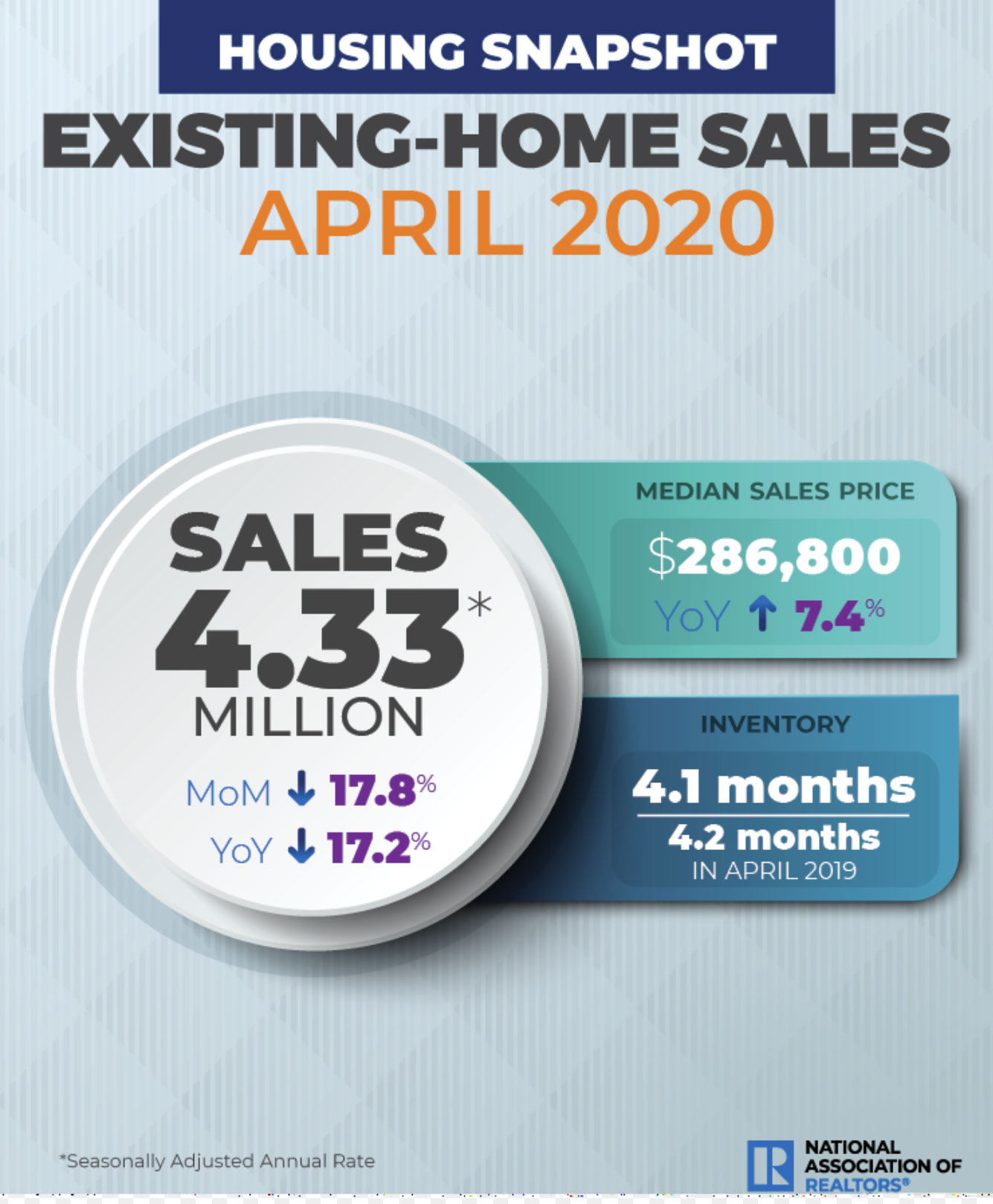The WPJ
THE WORLD PROPERTY JOURNALReal Estate Facts Not Fiction
Residential Real Estate News

Realtors Report U.S. Home Sales Implode in April, Down 17.8 Percent from Coronavirus
Residential News » Washington D.C. Edition | By Michael Gerrity | May 21, 2020 10:31 AM ET
According to the National Association of Realtors, existing-home sales dropped in April 2020, continuing what is now a two-month skid in sales brought on by the coronavirus pandemic. Each of the four major regions experienced a decline in month-over-month and year-over-year sales, with the West seeing the greatest dip in both categories.
Total existing-home sales, completed transactions that include single-family homes, townhomes, condominiums and co-ops, dropped 17.8% from March to a seasonally-adjusted annual rate of 4.33 million in April. Overall, sales decreased year-over-year, down 17.2% from a year ago (5.23 million in April 2019).
"The economic lockdowns - occurring from mid-March through April in most states - have temporarily disrupted home sales," said Lawrence Yun, NAR's chief economist. "But the listings that are on the market are still attracting buyers and boosting home prices."
April's existing-home sales are the lowest level of sales since July 2010 (3.45 million) and the largest month-over-month drop since July 2010 (-22.5%).
The median existing-home price for all housing types in April was $286,800, up 7.4% from April 2019 ($267,000), as prices increased in every region. April's national price increase marks 98 straight months of year-over-year gains.
"Record-low mortgage rates are likely to remain in place for the rest of the year, and will be the key factor driving housing demand as state economies steadily reopen," Yun said. "Still, more listings and increased home construction will be needed to tame price growth."
Total housing inventory at the end of April totaled 1.47 million units, down 1.3% from March, and down 19.7% from one year ago (1.83 million). Unsold inventory sits at a 4.1-month supply at the current sales pace, up from 3.4-months in March and down from the 4.2-month figure recorded in April 2019.
Properties typically remained on the market for 27 days in April, seasonally down from 29 days in March, but up from 24 days in April 2019. Fifty-six percent of homes sold in April 2020 were on the market for less than a month.
First-time buyers were responsible for 36% of sales in April, up from 34% in March 2020 and 32% in April 2019. NAR's 2019 Profile of Home Buyers and Sellers - released in late 2019 - revealed that the annual share of first-time buyers was 33%.
Individual investors or second-home buyers, who account for many cash sales, purchased 10% of homes in April, down from 13% in March 2020 and from 16% in April 2019. All-cash sales accounted for 15% of transactions in April, down from 19% in March 2020 and 20% in April 2019.
Distressed sales - foreclosures and short sales - represented 3% of sales in April, about even with both March 2020 and April 2019.
"While virtually every sector of the American economy has been hit hard by this pandemic, our nation's 1.4 million Realtors have continued to show an undying commitment to their profession, their clients and America's real estate industry," said NAR President Vince Malta, broker at Malta & Co., Inc., in San Francisco, Calif.
"As we find during any time of crisis, we have a tremendous opportunity to evolve and emerge stronger and more efficient," Malta continued. "Having renewed our focus on new, innovative ways to serve American consumers, I am confident the real estate sector and our nation's Realtors® are uniquely positioned to lead America's economic recovery."
Realtor.com®'s Market Hotness Index, measuring time-on-the-market data and listing views per property, revealed that the hottest metro areas in April were Colorado Springs, Colo.; Fort Wayne, Ind.; Topeka, Kan.; Pueblo, Colo.; and Columbus, Ohio.
According to Freddie Mac, the average commitment rate for a 30-year, conventional, fixed-rate mortgage decreased to 3.31% in April, down from 3.45% in March. The average commitment rate across all of 2019 was 3.94%.
Single-family and Condo/Co-op Sales
Single-family home sales sat at a seasonally-adjusted annual rate of 3.94 million in April, down 16.9% from 4.74 million in March, and down 15.5% from one year ago. The median existing single-family home price was $288,700 in April, up 7.3% from April 2019.
Existing condominium and co-op sales were recorded at a seasonally adjusted annual rate of 390,000 units in April, down 26.4% from March and down 31.6% from a year ago. The median existing condo price was $267,200 in April, an increase of 7.1% from a year ago.
"There appears to be a shift in preference for single-family homes over condominium dwellings," Yun said. "This trend could be long-lasting as remote work and larger housing needs will become widely prevalent even after we emerge from this pandemic."
Regional Breakdown
As was the case for the month prior, April sales decreased in every region from the previous month's levels. Median home prices in each region grew from one year ago, with the Northeast and Midwest regions showing the strongest price gains.
April 2020 existing-home sales in the Northeast fell 16.9%, recording an annual rate of 540,000, an 18.2% decrease from a year ago. The median price in the Northeast was $312,500, up 8.7% from April 2019.
Existing-home sales decreased 12.0% in the Midwest to an annual rate of 1.10 million, down 8.3% from a year ago. The median price in the Midwest was $229,200, a 9.3% increase from April 2019.
Existing-home sales in the South dropped 17.9% to an annual rate of 1.88 million in April, down 16.8% from the same time one year ago. The median price in the South was $249,400, a 6.4% increase from a year ago.
Existing-home sales in the West fell 25.0% to an annual rate of 810,000 in April, a 27.0% decline from a year ago. The median price in the West was $419,300, up 6.1% from April 2019.
Sign Up Free | The WPJ Weekly Newsletter
Relevant real estate news.
Actionable market intelligence.
Right to your inbox every week.
Real Estate Listings Showcase
Related News Stories
Residential Real Estate Headlines
- Las Vegas Area Home Prices Uptick 4.3 Percent Annually in March
- Single-Family Rent Growth in U.S. Trends Upward in 2025
- U.S. Mortgage Rates Tick Down Post Trump Tariffs Commencement
- President Trump's 'Liberation Day' Tariffs Potential Impact on the U.S. Housing and Mortgage Markets
- Baby Boomers Biggest Cohort of U.S. Home Buyers in 2025 as Millennials Decline
- U.S. Monthly Housing Payments Hit Record High in 2025
- U.S. Pending Home Sales Uptick in February
- Global Prime Residential Rent Slowdown Continued in Late 2024
- Ireland Home Price Inflation Hits 8 Year High in Early 2025
- Existing Home Sales in America Uptick in February
- Great Miami Area Residential Sales Decline 15 Percent Annually in February
- Mortgage Rates Uptick in Mid-March, Ending 9-Week Decline in U.S.
- World Property Ventures Builds the Future of Real Estate with New Funding Round
- U.S. Builder Sentiment Declines Amid Economic Uncertainty and Rising Costs
- Black Homeownership Rates in U.S. Enjoy Largest Annual Increase of All Racial Groups
- Wealthy Renters Are Taking Over More of the U.S. Rental Market
- If U.S. Congress Does Not Extend NFIP Soon, Thousands of Daily Home Closings Impacted
- U.S. Mortgage Applications Spike 11 Percent in Early March
- Greater Palm Beach Area Residential Sales Rise in Early 2025
- New Apartments in U.S. Are Leasing at Slowest Pace on Record
- U.S. Mortgage Rates Drop to 4 Month Low in March
- Overall U.S. Mortgage Delinquency Rates Dip in December
- New Tariffs on Canada, Mexico to Impact U.S. Homebuilder Input Costs
- Monaco's Property Market: A Tale of Two Cities
- U.S. Home Purchase Cancellations Surge, 1 in 7 Sales Getting Canceled
- U.S. Pending Home Sales Hit Historic Low in Early 2025
- Greater Miami Area Residential Sales Dip in January
- Governor DeSantis Supports Ending Property Taxes in Florida
- WPV Aims to Become the Berkshire Hathaway of Real Estate Tech
- U.S. Home Sales Slump Continues in January
- Average Americans Spend 38 Percent of Monthly Income on Mortgage Payments
- Switzerland's Safe-Haven Appeal Grows with World's Wealthy Homebuyers
- U.S. Builder Confidence Rapidly Declines in February
- Las Vegas Home Sales Rise 6.7 Percent Annually in January, Condo Sales Dip
- Homebuyer Demand in America Drops to 5-Year Low in Early 2025
- Ownership More Affordable Than Renting in Most U.S. Markets
- The World's First Global Listings Service Launches, Called a GLS
- Home Prices Continue to Rise in 89 Percent of U.S. Metros in Late 2024
- Global Luxury Residential Prices Showed Gradual Improvement in Late 2024
- U.S. Construction Hiring Rate Drops to Lowest Levels in 5 Years
Reader Poll
Marketplace Links
This website uses cookies to improve user experience. By using our website you consent in accordance with our Cookie Policy. Read More






